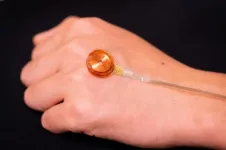(Press-News.org) An international archaeological study, led by researchers from the Culture and Socio-Ecological Dynamics (CaSEs) research group at Pompeu Fabra University, has advanced in the understanding and preservation of archaeological sites and in improving their analysis and surveying, thanks to the application of pXRF (portable X-ray fluorescence analysis) to anthropogenic sediments in Africa. It is a rapid, inexpensive, non-invasive procedure, which enables generating an additional archaeological record from the anthropogenic deposit by analysing chemical elements, combined with geostatistics.
It is a rapid, inexpensive, non-invasive procedure, which enables generating an additional archaeological record from the anthropogenic deposit by analysing chemical elements, combined with geostatistics.
The procedure, which has been successfully tested on the stone walled site of Seoke in Botswana, southern Africa, dating from the eighteenth century AD, is the result of research led by Stefano Biagetti, a member of the CaSEs research group, recently published in the journal PLOS ONE, co-funded by the Palarq Foundation. It has also involved CaSEs members Jonas Alcaina-Mateos, Abel Ruiz-Giralt, Carla Lancelotti and Shira Gur-Arie (now at the University of Munich, Germany), along with Patricia Groenewald (University of Cape Town, South Africa), Jordi Ibáñez-Insa (Geosciences Barcelona, GEO3BCN-CSIC), Fred Morton (University of Botswana), and Stefania Merlo (University of Cambridge, UK).View of the stone structures of Seoke
Stone-walled sites are settlements belonging to the southern African Iron Age, which emerged around 1200 AD, whose size and shape vary considerably. Their name reflects the dry stone wall structures that characterize them, and they were occupied by various Bantu-speaking farming and herding communities: they farmed, hunted and worshipped livestock as a source of both economic and political wealth.
"Our procedure goes beyond the visible archaeological evidence, as it provides information on the use that was made of the space, and confirms or clarifies the possible functions of the areas analysed".
Despite the long tradition of research on the use of space in these settlements, based mainly on ethnographic evidence and excavating small areas of some sites, to date it had proved difficult to perform this analysis using traditional approaches, beyond a general, large-scale architectural assessment: these sites were occupied for short periods of time (one or two generations), they are characterized by the scarce thickness of the archaeological deposits where few objects are found, and they include a large number of stone structures of similar morphology, which complicates identifying the various uses made of them.
"Our procedure goes beyond the visible archaeological evidence, as it provides information on the use that was made of the space, and confirms or clarifies the possible functions of the areas analysed. The research we have conducted has also revealed the existence of 'invisible' archaeological features that cannot be identified by naked eye in traditional field work", Stefano Biagetti explains. pXRF analysis provides rapid results (no more than four minutes per sample), enables analysing relatively large areas in a short time, and the field laboratory can be easily set up, avoiding having to transport large amounts of sediment.
A new approach to understand the functional and symbolic uses of the place
Human settlements can leave evidence in the form of chemical elements in site sediments, that allow identifying many human activities (e.g., areas of the home, for the preparation and consumption of food, burials, handicraft production, storage, livestock, etc.) . "The chemical markers provide an invaluable approach to determine past and recent activities of a place, to understand the spatial dynamics of these activities, and interpret architectural structures in relation to their functions and uses", the authors state.
The potential of this new approach lies in the fact that traces of chemical elements represent repetitive use in certain areas.
The potential of this new approach lies in the fact that traces of chemical elements represent repetitive use in certain areas. "The focus shifts from the absolute values of the chemical elements to their presence, combination, and especially any anomalies created by their deviation from the average for the samples", they state.
Having analysed the Seoke site using the pXRF device and a geostatistical technique called 'Kriging', the researchers detected, for example, phosphorus, indicating the presence of livestock; concentrations of organic materials, referring to the presence of middens; metals such as chromium, iron and zirconium, which fit the hypothesis of an area used as a workshop or for storage, where metal tools may have been used to shape pottery, clearing, wood-cutting, etc.; and silicon, indicating a possible area for processing and storing grain.
An innovative procedure that points to its use in future research
The authors stress that this pioneering procedure in the use of non-invasive techniques might enable unprecedented possibilities in understanding African archaeological sites, without disturbing the cultural heritage through new excavations. "The most promising achievement of our study is that pXRF performs well in the deposits of stone walled sites. The results presented here can be used critically to design surveys and digs at other sites of similar characteristics, and more generally at any other open-air site", they assure.
INFORMATION:
This research is part of the project "GeoEtnoarqueologia y uso del espacio (GEA)", directed by Stefano Biagetti and co-funded by the Palarq Foundation (2019 and 2020 calls), the School of Geography, Archaeology and Environmental Studies of the University of the Witwatersrand (Johannesburg, South Africa), and the University of Botswana.
Reference work: Biagetti, S., Alcaina-Mateos, J., Ruiz-Giralt, A., Lancelotti, C., Groenwald, P., Ibánez Insa, J., Gur-Arie, S., Morton, F., Merlo, S. (May 2021) "Identifying anthropogenic features at Seoke (Botswana) using pXRF: Expanding the record of southern African Stone Walled Sites". PLOS ONE
https://doi.org/10.1371/journal.pone.0250776
The work was conducted under the auspices of the Russian Foundation for Basic Research and organizations-participants of the BRICS framework program in science, technology and innovation; the grant title is "Nanosized peptide-based biomaterials for photodynamic diagnostics of tumors".
Project lead, Chief Research Associate of KFU's Bionanotechnology Lab Rawil Fakhrullin commented on the results, "The development of materials for theranostics (simultaneous early diagnosis and therapy of diseases) is one of the most urgent tasks in modern chemistry and biomedicine. A feature of such materials is the combination of at least two functions: sensory and therapeutic. ...
A research group led by Takashi Saito, of the Ehime University Graduate School of Medicine, developed a 2-photon excitation light-sheet fluorescence microscope which (1) lowers phototoxicity, (2) extends the field of view, and (3) heightens spatial resolution. This microscope, when used for the observation of medaka fish, made it possible to observe the whole body of the embryo (an extended field of view) at a cellular level resolution (high spatial resolution) without affecting the growth of the fish (low phototoxicity) over a three-day span of embryonic development. ...
The research team of the Department of Organic Chemistry of Samara Polytech under the leadership of Doctor of Chemical Sciences, Head of the Department Yuri Klimochkin and Doctor of Chemical Sciences, Professor Alexander Reznikov in cooperation with the crystallographic research group of Lomonosov Moscow State University (supervisor - candidate of chemical sciences, senior researcher Victor Rybakov) completed a study to obtain non-racemic 4,5-dihydrofurans based on Michael addition and study their chemical properties. The announcement of a scientific article with the results of the latest research is posted on the cover of the authoritative journal Tetrahedron.
"Studying the method of obtaining ...
CHAPEL HILL, NC - A new study published in Nature Communications demonstrates that a consortium of bacteria designed to complement missing or underrepresented functions in the imbalanced microbiome of inflammatory bowel disease (IBD) patients, prevented and treated chronic immune-mediated colitis in humanized mouse models. The study's senior author, Balfour Sartor, MD, Midget Distinguished Professor of Medicine, Microbiology and Immunology, Co-Director of the UNC Multidisciplinary IBD Center, said the results are encouraging for future use treating Crohn's disease and ulcerative colitis patients.
"The idea with this treatment is to restore the normal ...
Dark Matter Particle Explorer (DAMPE) Collaboration directly observed a spectral softening of helium nuclei at about 34TeV for the first time. This work was based on measurements data of the helium spectrum with kinetic energies from 70 GeV to 80 TeV (17.5 GeV/n to 20 TeV/n for per nucleon) recorded by the DAMPE.
The relevant results were published in Physical Review Letters.
Galactic cosmic rays (GCRs) offers important ways to deeply understand the astrophysical particle origin and accelerators and the interstellar medium of the Galaxy. Helium nuclei, the second most abundant nuclear element of cosmic rays, is a distinguishing feature of space.
As for GCRs, the energy spectrum is supposed to follow a negative power law distribution when energies are below the "knee" (at ...
By putting a piece of soft, strain-sensing sheet on the skin may be able to detect skin disorders non-invasively and in real-time very soon. A research team co-led by a scientist from City University of Hong Kong (CityU) has designed a simple electromechanical device that can be used for deep tissue pathology diagnosis, such as psoriasis, in an automated and non-invasive fashion. The findings will lay a foundation for future applications in the clinical evaluation of skin cancers and or dermatology diseases.
The research is co-led by Dr Yu Xinge, Assistant Professor from CityU's Department of Biomedical Engineering, and scientists from and Northwestern University in the US. Their findings have been published in the science journal Nature Biomedical Engineering, titled "Miniaturized ...
New Haven, Conn. -- The ancient burrowers of the seafloor have been getting a bum rap for years.
These prehistoric dirt churners -- a wide assortment of worms, trilobites, and other animals that lived in Earth's oceans hundreds of millions of years ago -- are thought to have played a key role in creating the conditions needed for marine life to flourish. Their activities altered the chemical makeup of the sea itself and the amount of oxygen in the oceans, in a process called bioturbation.
But did that bioturbation help or hinder the expansion of complex animal life? A new Yale study, published in the journal Earth and Planetary Science Letters, found that ...
New Haven, Conn. -- When San Francisco voters overwhelmingly approved a ballot measure banning the sale of flavored tobacco products in 2018, public health advocates celebrated. After all, tobacco use poses a significant threat to public health and health equity, and flavors are particularly attractive to youth.
But according to a new study from the Yale School of Public Health (YSPH), that law may have had the opposite effect. Analyses found that, after the ban's implementation, high school students' odds of smoking conventional cigarettes doubled in San Francisco's school district relative to trends in districts without the ban, even when adjusting for individual demographics and other ...
This new 3D effect can be the foundation for topological quantum phenomena, which are believed to be particularly robust and therefore promising candidates for extremely powerful quantum technologies. These results have just been published in the scientific journal Nature Communications.
Dr. Tobias Meng and Dr. Johannes Gooth are early career researchers in the Würzburg-Dresdner Cluster of Excellence ct.qmat that researches topological quantum materials since 2019. They could hardly believe the findings of a recent publication in "Nature" claiming that electrons in the topological metal zirconium pentatelluride (ZrTe5) move only in two-dimensional ...
WHAT:
An environment in which family members support one another and express their feelings can reduce the effects of social deprivation on cognitive ability and development among adopted children, suggests a small study by researchers at the National Institutes of Health. In contrast, rule-driven households where family members are in conflict may increase an adopted child's chances for cognitive, behavioral and emotional difficulties.
The study was conducted by Margaret F. Keil, Ph.D., and colleagues in the Section on Endocrinology and Genetics at NIH's Eunice Kennedy Shriver National Institute of Child Health and Human Development (NICHD). It appears in Pediatric Research.
Researchers enrolled children who had spent at least eight ...





